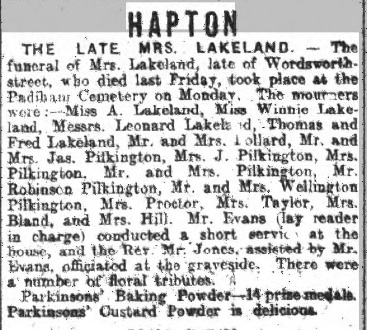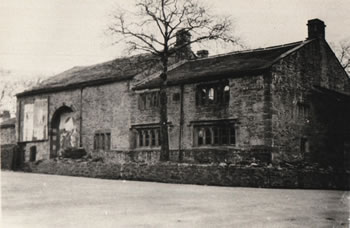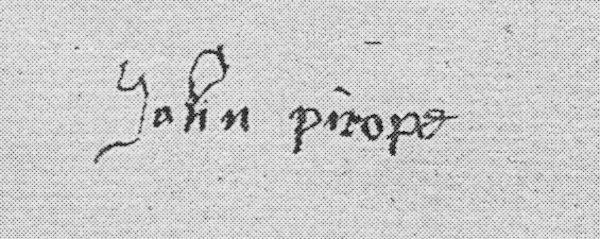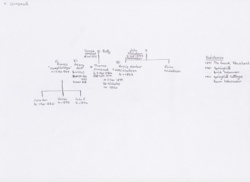August 2015
52 residents #35 Wellington Pilkington
29/08/15 11:37
Mmm with a name like that, he must be easy to track in the search engines, yes?
So I put him into a well known genealogy database: 6383 results. Really?
Try again in another well known database: 35.
That's more like it.
(for the record, the third major contender came up with 4731. mmm. Lets go with option 2 I think. To start with at any rate).
Wellington Pilkington was another of the unfortunate Springhill residents to lose his life in WW1.
b 3q 1886 Haslingden registration district to Thomas and Alice Pilkington.
The family obviously liked to name their children after major military figures as he had a sibling named Lord Nelson Pilkington. Perhaps it was fitting that in 1891 the family lived at Napoleon's buildings, Cawl Terrace, Cloughfold where the enumerator helpfully records that Wellington and several of his siblings were born.
For the record, siblings are:
Joseph b ~ 1865
Nellie b ~ 1867
Jane b ~ 1868
James Edward b ~ 1870
Willie b ~ 1875
Robinson b ~ 1876
William Carr b ~ 1877 (not Willie, different place of birth)
(Thomas married Alice Lord, Haslingden, q3 1885)
(Wellington b 1887)
Lord Nelson b ~ 1887
Polly b ~1893
Alice b ~ 1894
Leonard b ~ 1899
He married Emily Blunt in q3 1906 and by 1911 was living in 17 Greenhill with his wife and children Margaret Alice (b~ 1907) and Thomas (b~1910). Wellington and Emily were both cotton weavers.
So WW1 came and Wellington enlisted in 9 Btn East Lancs, reg no. 14959 . He entered the theatre of war (1 - so Western Europe somewhere) on 5/9/15 (thus getting his 1915 star).
He was killed in action on 27 Dec 1916 in Salonika.
British Pathe footage of the Salonika campaign. I haven't checked these.
And a bizarre piece of product placement from the Burnley Express 27 March 1915:

Sources:
birth GRO 8e 118
1881 census RG 11/4131 p 172-3
marriage Thomas - Alice 8e 202
1891 census RG 12/3351 p 14
marriage Wellington - Emily 8e 258
1901 census RG 13/3850 folio 79 p 27
So I put him into a well known genealogy database: 6383 results. Really?
Try again in another well known database: 35.
That's more like it.
(for the record, the third major contender came up with 4731. mmm. Lets go with option 2 I think. To start with at any rate).
Wellington Pilkington was another of the unfortunate Springhill residents to lose his life in WW1.
b 3q 1886 Haslingden registration district to Thomas and Alice Pilkington.
The family obviously liked to name their children after major military figures as he had a sibling named Lord Nelson Pilkington. Perhaps it was fitting that in 1891 the family lived at Napoleon's buildings, Cawl Terrace, Cloughfold where the enumerator helpfully records that Wellington and several of his siblings were born.
For the record, siblings are:
Joseph b ~ 1865
Nellie b ~ 1867
Jane b ~ 1868
James Edward b ~ 1870
Willie b ~ 1875
Robinson b ~ 1876
William Carr b ~ 1877 (not Willie, different place of birth)
(Thomas married Alice Lord, Haslingden, q3 1885)
(Wellington b 1887)
Lord Nelson b ~ 1887
Polly b ~1893
Alice b ~ 1894
Leonard b ~ 1899
He married Emily Blunt in q3 1906 and by 1911 was living in 17 Greenhill with his wife and children Margaret Alice (b~ 1907) and Thomas (b~1910). Wellington and Emily were both cotton weavers.
So WW1 came and Wellington enlisted in 9 Btn East Lancs, reg no. 14959 . He entered the theatre of war (1 - so Western Europe somewhere) on 5/9/15 (thus getting his 1915 star).
He was killed in action on 27 Dec 1916 in Salonika.
British Pathe footage of the Salonika campaign. I haven't checked these.
And a bizarre piece of product placement from the Burnley Express 27 March 1915:

Sources:
birth GRO 8e 118
1881 census RG 11/4131 p 172-3
marriage Thomas - Alice 8e 202
1891 census RG 12/3351 p 14
marriage Wellington - Emily 8e 258
1901 census RG 13/3850 folio 79 p 27
52 residents #34 John Piccoppe
22/08/15 23:09
We have met John Piccoppe before in this series. In week 22 I considered the speculation that Johannes Kippax resigned his living in 1662 to lead the dissenting congregation in Rossendale.
John Piccoppe owned the barn in which this congregation was granted a licence to meet in 1672.
It was probably, but not absolutely certainly, the barn at Lodge Fold Farm which stood in the centre of Higher Cloughfold on the southern boundary of Springhill. Lodge Fold Farm was built in 1629 and rebuilt in 1854.

It stood until 1936 when it was sadly demolished for road widening, being replaced by a grassed area, a bus stop and a set of public toilets. Given the speeds at which cars traverse the village, many wished it had been retained for traffic calming…

The 1629 datestone was removed when the farm was demolished and set in a 'history wall' in the grounds of Whitaker Museum in Rawtenstall, from which it was removed one night with the 'assistance' of a JCB. It was the only stone taken.
So much for the barn, what of the man?
John Piccop of Deadwenclough received wages in 1672 'for the graveship of the Forest of Rossendale' from John Ormerod
(LRO NCHa/71/2. Quite why they are filed with the records of the National Coal Board I'm not sure…it is under 'Miscellaneous'…) This is not on the list of Greaves in Newbigging's 'History of the Forest of Rossendale'.
John s James Piccop was baptised May 1630 Newchurch St Nicholas (LDS Film 1040340) This John would be age 42 in 1672 so plausible, indeed he is the only plausible candidate baptised at Newchurch. However there is no guarantee he was baptised there or, given his later nonconformist sympathies, baptised at all.
Putative marriages, all St Nicholas:
Elizabeth Mills 22 Nov 1663 (bur 30 Jan 1668/9)
Dorothy Hamar 8 Jul 1669 (bur 9 Jul 1680)
Alice Whittaker 19 April 1676 (poss bur 6 Oct 1688 abode 'Wainyate', or 11 June 1680)
Jana Heyworth 5 Nov 1671
Alice of Wainyate is an interesting candidate given his interests in the area.
Johannes Piccop bur 20 Jun 1691 St Nicholas, abode Dewinclough. Sion was still meeting in private property and didn't have a graveyard at that time. He is not listed in the register of interments for the Rossendale Quaker burial grounds. Again, these are speculative.
So actual facts are scanty. However, if he was the Greave in 1672, we may have his signature…

John Piccoppe owned the barn in which this congregation was granted a licence to meet in 1672.
It was probably, but not absolutely certainly, the barn at Lodge Fold Farm which stood in the centre of Higher Cloughfold on the southern boundary of Springhill. Lodge Fold Farm was built in 1629 and rebuilt in 1854.

It stood until 1936 when it was sadly demolished for road widening, being replaced by a grassed area, a bus stop and a set of public toilets. Given the speeds at which cars traverse the village, many wished it had been retained for traffic calming…

The 1629 datestone was removed when the farm was demolished and set in a 'history wall' in the grounds of Whitaker Museum in Rawtenstall, from which it was removed one night with the 'assistance' of a JCB. It was the only stone taken.
So much for the barn, what of the man?
John Piccop of Deadwenclough received wages in 1672 'for the graveship of the Forest of Rossendale' from John Ormerod
(LRO NCHa/71/2. Quite why they are filed with the records of the National Coal Board I'm not sure…it is under 'Miscellaneous'…) This is not on the list of Greaves in Newbigging's 'History of the Forest of Rossendale'.
John s James Piccop was baptised May 1630 Newchurch St Nicholas (LDS Film 1040340) This John would be age 42 in 1672 so plausible, indeed he is the only plausible candidate baptised at Newchurch. However there is no guarantee he was baptised there or, given his later nonconformist sympathies, baptised at all.
Putative marriages, all St Nicholas:
Elizabeth Mills 22 Nov 1663 (bur 30 Jan 1668/9)
Dorothy Hamar 8 Jul 1669 (bur 9 Jul 1680)
Alice Whittaker 19 April 1676 (poss bur 6 Oct 1688 abode 'Wainyate', or 11 June 1680)
Jana Heyworth 5 Nov 1671
Alice of Wainyate is an interesting candidate given his interests in the area.
Johannes Piccop bur 20 Jun 1691 St Nicholas, abode Dewinclough. Sion was still meeting in private property and didn't have a graveyard at that time. He is not listed in the register of interments for the Rossendale Quaker burial grounds. Again, these are speculative.
So actual facts are scanty. However, if he was the Greave in 1672, we may have his signature…

52 residents #33 Charles Patrick
16/08/15 22:22
I have reproduced my original blog post about Charles Patrick from April 2014. In many ways he is integral to this OPS and his influence on Springhill and the surrounding area was huge.
'The house was 120 years old, with 120 years old timbers and 120 years old joists. It creaked a bit and wind blew down chimneys and through ill-fitting windows. The little girl, unnerved by the noises, was reassured that it was only ’the Capting’.
“The Capting” - Captain Charles Patrick - was a previous owner of the house. The little girl amused herself with stories of the dashing army captain, her war hero. Later she passed them down to her daughter. So it came as a bit of a disappointment to the little girl when she discovered that the Capting was actually a sub-inspector of factories.
The Capting did not build the house. That was there before, built some 30 or so years before the Capting by a colliery proprietor who wanted a residence commensurate which his wealth and status. Rather the Capting married well, marrying the spinster daughter of the late collier who was ‘living off her own means’. He soon exerted his presence, extending the house and employing 2 extra house servants plus a gardener and a groom. The little girl often told her daughter that she thought the Capting lived well off his wife’s money.
He was not a local man, suddenly appearing in a nearby town apparently from nowhere.Yet he became a figure in the local community. A prominent Churchman, Conservative, Freemason and Local Government Board member he chaired meetings, gave speeches and made donations. His poultry, horses and pigs won prizes and the Capting would proclaim toasts at the after-fair dinner. He could turn a phrase which could turn a debate or convince a judge. But perhaps a bit devil-may-care; despite knowing a landowner banned huntsmen from his land, the Capting would hunt first and pay damages later. Perhaps the dashing image of the little girl wasn’t too far out. But she was beginning to believe that perhaps the Capting had not been above embellishing his army record to enhance his social standing and details of the ‘considerable active service abroad to which his obituary refers have proved stubbornly elusive. Was his army record really limited to his being a Captain in the yeomanary reserves?
The Capting and his wife were philanthropic, giving land and money to endow a school and a church. He could also be more quietly generous, paying the poor rate for his tenants in a year of bad harvests. And there is something attractive about a man working to uphold the law and prevent exploitation. He led investigations outside his own areas, including one in Strangeways prison. He even went as far as disguising himself as a tramp, so as not to be recognised by the mill owners. Yet on at least one occasion a mill owner was acquitted because the Capting had set his watch by the incorrect clock.
He brought land and property, ultimately owning much of the village and a fair bit of the next one as well. There was no issue from the marriage and on his death the estate was divided between his wife’s two nieces. The village square was renamed in his memory. The church and school he endowed still thrive.
The house was divided too, first into two then into three, with various outbuildings being converted into dwellings. One portion was bought by the little girl’s father. Five generations of the family have lived there, listening to the timber creak and remembering the Capting.'
There are seven pages on this site directly related to Patrick. There are many unanswered questions however:
Charles Patrick was born in Winchmore Hill, Middlesex. His family lived in Lincolnshire and Edinburgh during his childhood. Why did they move?
His army service has since been demonstrated to be in Canada - why did he move there? Does that count as 'considerable active service abroad' as I haven't yet found any evidence of engagement?
Why did he return from Canada to become sub-inspector of factories in Rochdale?
How did he meet and woo Mary Ann Ashworth?
His will refers to a separate one relating only to property in Canada - what and where?
There may not be time to pursue all of these and there are limits to the extent to which a one-place study can poke outside the place. But its fun…
'The house was 120 years old, with 120 years old timbers and 120 years old joists. It creaked a bit and wind blew down chimneys and through ill-fitting windows. The little girl, unnerved by the noises, was reassured that it was only ’the Capting’.
“The Capting” - Captain Charles Patrick - was a previous owner of the house. The little girl amused herself with stories of the dashing army captain, her war hero. Later she passed them down to her daughter. So it came as a bit of a disappointment to the little girl when she discovered that the Capting was actually a sub-inspector of factories.
The Capting did not build the house. That was there before, built some 30 or so years before the Capting by a colliery proprietor who wanted a residence commensurate which his wealth and status. Rather the Capting married well, marrying the spinster daughter of the late collier who was ‘living off her own means’. He soon exerted his presence, extending the house and employing 2 extra house servants plus a gardener and a groom. The little girl often told her daughter that she thought the Capting lived well off his wife’s money.
He was not a local man, suddenly appearing in a nearby town apparently from nowhere.Yet he became a figure in the local community. A prominent Churchman, Conservative, Freemason and Local Government Board member he chaired meetings, gave speeches and made donations. His poultry, horses and pigs won prizes and the Capting would proclaim toasts at the after-fair dinner. He could turn a phrase which could turn a debate or convince a judge. But perhaps a bit devil-may-care; despite knowing a landowner banned huntsmen from his land, the Capting would hunt first and pay damages later. Perhaps the dashing image of the little girl wasn’t too far out. But she was beginning to believe that perhaps the Capting had not been above embellishing his army record to enhance his social standing and details of the ‘considerable active service abroad to which his obituary refers have proved stubbornly elusive. Was his army record really limited to his being a Captain in the yeomanary reserves?
The Capting and his wife were philanthropic, giving land and money to endow a school and a church. He could also be more quietly generous, paying the poor rate for his tenants in a year of bad harvests. And there is something attractive about a man working to uphold the law and prevent exploitation. He led investigations outside his own areas, including one in Strangeways prison. He even went as far as disguising himself as a tramp, so as not to be recognised by the mill owners. Yet on at least one occasion a mill owner was acquitted because the Capting had set his watch by the incorrect clock.
He brought land and property, ultimately owning much of the village and a fair bit of the next one as well. There was no issue from the marriage and on his death the estate was divided between his wife’s two nieces. The village square was renamed in his memory. The church and school he endowed still thrive.
The house was divided too, first into two then into three, with various outbuildings being converted into dwellings. One portion was bought by the little girl’s father. Five generations of the family have lived there, listening to the timber creak and remembering the Capting.'
There are seven pages on this site directly related to Patrick. There are many unanswered questions however:
Charles Patrick was born in Winchmore Hill, Middlesex. His family lived in Lincolnshire and Edinburgh during his childhood. Why did they move?
His army service has since been demonstrated to be in Canada - why did he move there? Does that count as 'considerable active service abroad' as I haven't yet found any evidence of engagement?
Why did he return from Canada to become sub-inspector of factories in Rochdale?
How did he meet and woo Mary Ann Ashworth?
His will refers to a separate one relating only to property in Canada - what and where?
There may not be time to pursue all of these and there are limits to the extent to which a one-place study can poke outside the place. But its fun…
52 residents #32 Thomas Ormerod
07/08/15 23:00
Thomas Ormerod lived pretty much all his life in Springhill or the immediately surrounding area. It is quite possible that he scarcely ventured outside a radius of a couple of miles or so.
He was born ~1842 in 'Cloughfold' at a time when Cloughfold comprised of only a couple of dozen properties or so. He was the 5th son of George Ormerod, Stone Mason and his wife Betty. He is still there, in 'Cloughfold', in 1851. Thanks Mr Enumerator for pinning down the houses so precisely…
It was no better in 1861, when Thomas was living in 'Cloughfold' with his parents. By this time he was working as a labourer. Interestingly this household on census night included three grandchildren of George and Betty, each with different surnames… Schofield, Ingham and Ormerod. Mmm.
1871 finds him married to Fanny with two children, John Thos (b ~ 1866) and Jane Ann (b ~ 1870). He is now a farm servant in 'Cloughfold'. In 1866 at the baptism of John Thomas (at Newchurch St Nicholas) his occupation is given as 'gardener'.

1881 'Thirteen Cloughfold' with wife Mary Ann (b Preston, ~ 1842) and children Jane (b ~ 1870), James (b ~ 1871) and John Richard (b ~ 1873) together with a niece Sarah Jane Lonsdale, b Cloughfold ~ 1855 and male lodger John Taylor. By this time he was a farm labourer.
1891 'The Green, Newchurch' with third wife Annie, all of 1/2 mile away if that. Occupation at this time was 'labourer in general'
1901 and 1911 in Springhill. In 1901 this is specified as Springhill Cottage, now a substantial dwelling. He was a farm labourer on both censuses. It is probable that at least some of his time as a farm lab was spent working on Springhill Farm.
He did nothing remarkable that we know of, getting on with his life. Life was sad at times, with him burying two wives, work hard and finances probably tight.
He was born ~1842 in 'Cloughfold' at a time when Cloughfold comprised of only a couple of dozen properties or so. He was the 5th son of George Ormerod, Stone Mason and his wife Betty. He is still there, in 'Cloughfold', in 1851. Thanks Mr Enumerator for pinning down the houses so precisely…
It was no better in 1861, when Thomas was living in 'Cloughfold' with his parents. By this time he was working as a labourer. Interestingly this household on census night included three grandchildren of George and Betty, each with different surnames… Schofield, Ingham and Ormerod. Mmm.
1871 finds him married to Fanny with two children, John Thos (b ~ 1866) and Jane Ann (b ~ 1870). He is now a farm servant in 'Cloughfold'. In 1866 at the baptism of John Thomas (at Newchurch St Nicholas) his occupation is given as 'gardener'.

1881 'Thirteen Cloughfold' with wife Mary Ann (b Preston, ~ 1842) and children Jane (b ~ 1870), James (b ~ 1871) and John Richard (b ~ 1873) together with a niece Sarah Jane Lonsdale, b Cloughfold ~ 1855 and male lodger John Taylor. By this time he was a farm labourer.
1891 'The Green, Newchurch' with third wife Annie, all of 1/2 mile away if that. Occupation at this time was 'labourer in general'
1901 and 1911 in Springhill. In 1901 this is specified as Springhill Cottage, now a substantial dwelling. He was a farm labourer on both censuses. It is probable that at least some of his time as a farm lab was spent working on Springhill Farm.
He did nothing remarkable that we know of, getting on with his life. Life was sad at times, with him burying two wives, work hard and finances probably tight.




